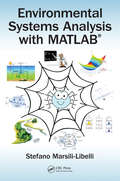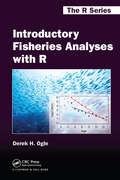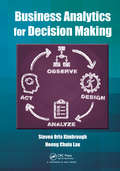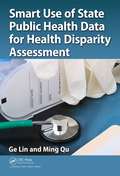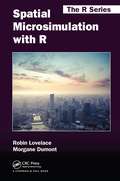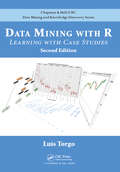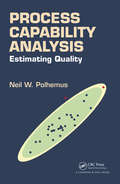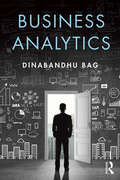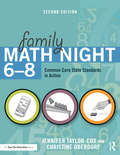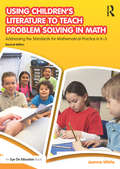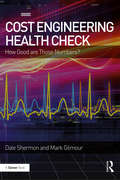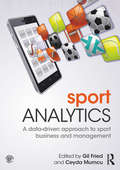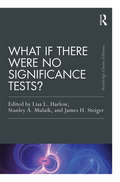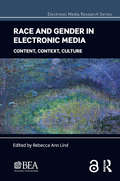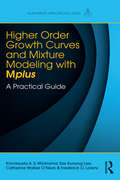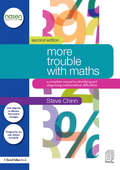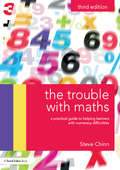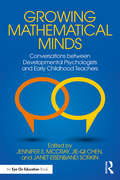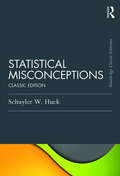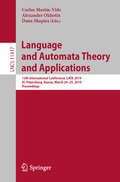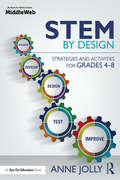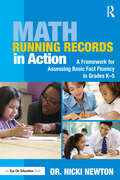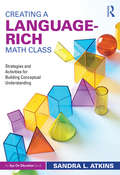- Table View
- List View
Environmental Systems Analysis with MATLAB®
by Stefano Marsili-LibelliExplore the inner workings of environmental processes using a mathematical approach. Environmental Systems Analysis with MATLAB® combines environmental science concepts and system theory with numerical techniques to provide a better understanding of how our environment works. The book focuses on building mathematical models of environmental systems, and using these models to analyze their behaviors. Designed with the environmental professional in mind, it offers a practical introduction to developing the skills required for managing environmental modeling and data handling. The book follows a logical sequence from the basic steps of model building and data analysis to implementing these concepts into working computer codes, and then on to assessing their results. It describes data processing (rarely considered in environmental analysis); outlines the tools needed to successfully analyze data and develop models, and moves on to real-world problems. The author illustrates in the first four chapters the methodological aspects of environmental systems analysis, and in subsequent chapters applies them to specific environmental concerns. The accompanying software bundle is freely downloadable from the book web site. It follows the chapters sequence and provides a hands-on experience, allowing the reader to reproduce the figures in the text and experiment by varying the problem setting. A basic MATLAB literacy is required to get the most out of the software. Ideal for coursework and self-study, this offering: Deals with the basic concepts of environmental modeling and identification, both from the mechanistic and the data-driven viewpoint Provides a unifying methodological approach to deal with specific aspects of environmental modeling: population dynamics, flow systems, and environmental microbiology Assesses the similarities and the differences of microbial processes in natural and man-made environments Analyzes several aquatic ecosystems’ case studies Presents an application of an extended Streeter & Phelps (S&P) model Describes an ecological method to estimate the bioavailable nutrients in natural waters Considers a lagoon ecosystem from several viewpoints, including modeling and management, and more
Introductory Fisheries Analyses with R (Chapman & Hall/CRC The R Series)
by Derek H. OgleA How-To Guide for Conducting Common Fisheries-Related Analyses in R Introductory Fisheries Analyses with R provides detailed instructions on performing basic fisheries stock assessment analyses in the R environment. Accessible to practicing fisheries scientists as well as advanced undergraduate and graduate students, the book demonstrates the flexibility and power of R, offers insight into the reproducibility of script-based analyses, and shows how the use of R leads to more efficient and productive work in fisheries science. The first three chapters present a minimal introduction to the R environment that builds a foundation for the fisheries-specific analyses in the remainder of the book. These chapters help you become familiar with R for basic fisheries analyses and graphics. Subsequent chapters focus on methods to analyze age comparisons, age-length keys, size structure, weight-length relationships, condition, abundance (from capture-recapture and depletion data), mortality rates, individual growth, and the stock-recruit relationship. The fundamental statistical methods of linear regression, analysis of variance (ANOVA), and nonlinear regression are demonstrated within the contexts of these common fisheries analyses. For each analysis, the author completely explains the R functions and provides sufficient background information so that you can confidently implement each method. Web Resource The author’s website at http://derekogle.com/IFAR/ includes the data files and R code for each chapter, enabling you to reproduce the results in the book as well as create your own scripts. The site also offers supplemental code for more advanced analyses and practice exercises for every chapter.
Business Analytics for Decision Making
by Steven Orla Kimbrough Hoong Chuin LauBusiness Analytics for Decision Making, the first complete text suitable for use in introductory Business Analytics courses, establishes a national syllabus for an emerging first course at an MBA or upper undergraduate level. This timely text is mainly about model analytics, particularly analytics for constrained optimization. It uses implementations that allow students to explore models and data for the sake of discovery, understanding, and decision making.Business analytics is about using data and models to solve various kinds of decision problems. There are three aspects for those who want to make the most of their analytics: encoding, solution design, and post-solution analysis. This textbook addresses all three. Emphasizing the use of constrained optimization models for decision making, the book concentrates on post-solution analysis of models. The text focuses on computationally challenging problems that commonly arise in business environments. Unique among business analytics texts, it emphasizes using heuristics for solving difficult optimization problems important in business practice by making best use of methods from Computer Science and Operations Research. Furthermore, case studies and examples illustrate the real-world applications of these methods. The authors supply examples in Excel®, GAMS, MATLAB®, and OPL. The metaheuristics code is also made available at the book's website in a documented library of Python modules, along with data and material for homework exercises. From the beginning, the authors emphasize analytics and de-emphasize representation and encoding so students will have plenty to sink their teeth into regardless of their computer programming experience.
Smart Use of State Public Health Data for Health Disparity Assessment
by Ge Lin Ming QuHealth services are often fragmented along organizational lines with limited communication among the public health–related programs or organizations, such as mental health, social services, and public health services. This can result in disjointed decision making without necessary data and knowledge, organizational fragmentation, and disparate knowledge development across the full array of public health needs. When new questions or challenges arise that require collaboration, individual public health practitioners (e.g., surveillance specialists and epidemiologists) often do not have the time and energy to spend on them. Smart Use of State Public Health Data for Health Disparity Assessment promotes data integration to aid crosscutting program collaboration. It explains how to maximize the use of various datasets from state health departments for assessing health disparity and for disease prevention. The authors offer practical advice on state public health data use, their strengths and weaknesses, data management insight, and lessons learned. They propose a bottom-up approach for building an integrated public health data warehouse that includes localized public health data. The book is divided into three sections: Section I has seven chapters devoted to knowledge and skill preparations for recognizing disparity issues and integrating and analyzing local public health data. Section II provides a systematic surveillance effort by linking census tract poverty to other health disparity dimensions. Section III provides in-depth studies related to Sections I and II. All data used in the book have been geocoded to the census tract level, making it possible to go more local, even down to the neighborhood level.
Spatial Microsimulation with R (Chapman & Hall/CRC The R Series)
by Robin Lovelace Morgane DumontGenerate and Analyze Multi-Level Data Spatial microsimulation involves the generation, analysis, and modeling of individual-level data allocated to geographical zones. Spatial Microsimulation with R is the first practical book to illustrate this approach in a modern statistical programming language. Get Insight into Complex BehaviorsThe book progresses from the principles underlying population synthesis toward more complex issues such as household allocation and using the results of spatial microsimulation for agent-based modeling. This equips you with the skills needed to apply the techniques to real-world situations. The book demonstrates methods for population synthesis by combining individual and geographically aggregated datasets using the recent R packages ipfp and mipfp. This approach represents the "best of both worlds" in terms of spatial resolution and person-level detail, overcoming issues of data confidentiality and reproducibility. Implement the Methods on Your Own DataFull of reproducible examples using code and data, the book is suitable for students and applied researchers in health, economics, transport, geography, and other fields that require individual-level data allocated to small geographic zones. By explaining how to use tools for modeling phenomena that vary over space, the book enhances your knowledge of complex systems and empowers you to provide evidence-based policy guidance.
Data Mining with R: Learning with Case Studies, Second Edition (Chapman & Hall/CRC Data Mining and Knowledge Discovery Series)
by Luis TorgoData Mining with R: Learning with Case Studies, Second Edition uses practical examples to illustrate the power of R and data mining. Providing an extensive update to the best-selling first edition, this new edition is divided into two parts. The first part will feature introductory material, including a new chapter that provides an introduction to data mining, to complement the already existing introduction to R. The second part includes case studies, and the new edition strongly revises the R code of the case studies making it more up-to-date with recent packages that have emerged in R. The book does not assume any prior knowledge about R. Readers who are new to R and data mining should be able to follow the case studies, and they are designed to be self-contained so the reader can start anywhere in the document. The book is accompanied by a set of freely available R source files that can be obtained at the book’s web site. These files include all the code used in the case studies, and they facilitate the "do-it-yourself" approach followed in the book. Designed for users of data analysis tools, as well as researchers and developers, the book should be useful for anyone interested in entering the "world" of R and data mining. About the Author Luís Torgo is an associate professor in the Department of Computer Science at the University of Porto in Portugal. He teaches Data Mining in R in the NYU Stern School of Business’ MS in Business Analytics program. An active researcher in machine learning and data mining for more than 20 years, Dr. Torgo is also a researcher in the Laboratory of Artificial Intelligence and Data Analysis (LIAAD) of INESC Porto LA.
Process Capability Analysis: Estimating Quality
by Neil W. PolhemusProcess Capability Analysis: Estimating Quality presents a systematic exploration of process capability analysis and how it may be used to estimate quality. The book is designed for practitioners who are tasked with insuring a high level of quality for the products and services offered by their organizations. Along with describing the necessary statistical theory, the book illustrates the practical application of the techniques to data that do not always satisfy the standard assumptions. The first two chapters deal with attribute data, where the estimation of quality is restricted to counts of nonconformities. Both classical and Bayesian methods are discussed. The rest of the book deals with variable data, including extensive discussions of both capability indices and statistical tolerance limits. Considerable emphasis is placed on methods for handling non-normal data. Also included are discussions of topics often omitted in discussions of process capability, including multivariate capability indices, multivariate tolerance limits, and capability control charts. A separate chapter deals with the problem of determining adequate sample sizes for estimating process capability. Features: Comprehensive treatment of the subject with consistent theme of estimating percent of nonconforming product or service. Includes Bayesian methods. Extension of univariate techniques to multivariate data. Demonstration of all techniques using Statgraphics data analysis software. Neil Polhemus is Chief Technology Officer at Statgraphics Technology and the original developer of the Statgraphics program for statistical analysis and data visualization. Dr. Polhemus spent 6 years on the faculty of the School of Engineering and Applied Science at Princeton University before moving full-time to software development and consulting. He has taught courses dealing with statistical process control, design of experiments and data analysis for more than 100 companies and government agencies.
Business Analytics
by Dinabandhu BagThis book provides a first-hand account of business analytics and its implementation, and an account of the brief theoretical framework underpinning each component of business analytics. The themes of the book include (1) learning the contours and boundaries of business analytics which are in scope; (2) understanding the organization design aspects of an analytical organization; (3) providing knowledge on the domain focus of developing business activities for financial impact in functional analysis; and (4) deriving a whole gamut of business use cases in a variety of situations to apply the techniques. The book gives a complete, insightful understanding of developing and implementing analytical solution.
Family Math Night 6-8: Common Core State Standards in Action
by Jennifer Taylor-Cox Christine OberdorfHost Family Math Nights at your middle school—starting today! Family Math Nights are a great way for teachers to get parents involved in their children’s education and to promote math learning outside of the classroom. In this practical book, you’ll find step-by-step guidelines and activities to help you bring Family Math Nights to life. The enhanced second edition is aligned with the Common Core State Standards for Mathematical Content and Practice with new activities to help students explain their answers and write about math. It also comes with ready-to-use handouts that you can distribute during your event. With the resources in this book, you’ll have everything you need to help students learn essential math concepts—including ratios and proportional relationships, the number system, expressions and equations, geometry, and statistics and probability—in a fun and supportive environment. Special Features: The book is organized by math content, so you can quickly find activities that meet your needs. Each activity is easy to implement and includes a page of instructions educators can use to prepare the station, as well as a page for families that explains the activity and can be photocopied and displayed at the station. All of the family activities can be photocopied or downloaded from our website, www.routledge.com/9781138200999, so that you can distribute them during your event.
Using Children's Literature to Teach Problem Solving in Math: Addressing the Standards for Mathematical Practice in K–5
by Jeanne WhiteLearn how children’s literature can help K–5 students see the real-life applications of mathematical concepts. This user-friendly book shows how to use stories to engage students in building critical reasoning, abstract thinking, and communication skills, all while helping students understand the relevance of math in their everyday lives. Each chapter is dedicated to one of the eight Standards for Mathematical Practice, and offers examples of children’s literature that can be used to help students develop that practice. You’ll find out how to: Encourage students to persevere in solving mathematical problems and use multiple approaches to find the answer; Help students reason abstractly with the aid of concrete objects and visuals; Guide students in constructing arguments to explain their reasoning and engage in critical discussion with their peers; Teach students to recognize mathematical patterns and use them to solve problems efficiently; And more! The book offers activities for beginners as well as for more advanced problem solvers. Each chapter also provides guidance for ELLs and students with special needs, so no matter your classroom environment, you’ll be able to use these strategies to make math class more dynamic, engaging, and fun.
Cost Engineering Health Check: How Good are Those Numbers?
by Dale Shermon Mark GilmourHigh quality cost estimating gives a business leader confidence to make rational financial decisions. Whether you are a business leader or a cost estimating manager, you have a vested interest in understanding whether you can depend on your organisation's ability to generate accurate cost forecasts and estimates. But how can business leaders have confidence that the cost information that they are being provided with is of high quality? How can a cost estimating manager be sure that their team is providing high quality cost information? QinetiQ's Cost Engineering Health Check is used as a capability benchmarking tool to identify improvement opportunities within their clients' cost estimating capability, enabling them to focus on areas that have the potential to increase their competitiveness. High quality estimating leads to accurate budgets, a reduced potential for cost growth, accurate evaluation of risk exposure, and the opportunity to implement effective earned value management (EVM). The Cost Engineering Health Check employs a standardised competency framework that considers all aspects of cost estimating capability, and provides an objective assessment against both best practice and the industry standard. This framework is based on QinetiQ's long established, tried and tested, Knowledge Based Estimating (KBE) philosophy comprising Data, Tools, People and Process, with additional consideration given to cultural and stakeholder assessments.
Sport Analytics: A data-driven approach to sport business and management
by Gil Fried Ceyda MumcuThe increasing availability of data has transformed the way sports are played, promoted and managed. This is the first textbook to explain how the big data revolution is having a profound influence across the sport industry, demonstrating how sport managers and business professionals can use analytical techniques to improve their professional practice. While other sports analytics books have focused on player performance data, this book shows how analytics can be applied to every functional area of sport business, from marketing and event management to finance and legal services. Drawing on research that spans the entire sport industry, it explains how data is influencing the most important decisions, from ticket sales and human resources to risk management and facility operations. Each chapter contains real world examples, industry profiles and extended case studies which are complimented by a companion website full of useful learning resources. Sport Analytics: A data-driven approach to sport business and management is an essential text for all sport management students and an invaluable reference for any sport management professional involved in operational research.
What If There Were No Significance Tests?: Classic Edition (Multivariate Applications Series)
by Lisa L. Harlow Stanley A. Mulaik James H. SteigerThe classic edition of What If There Were No Significance Tests? highlights current statistical inference practices. Four areas are featured as essential for making inferences: sound judgment, meaningful research questions, relevant design, and assessing fit in multiple ways. Other options (data visualization, replication or meta-analysis), other features (mediation, moderation, multiple levels or classes), and other approaches (Bayesian analysis, simulation, data mining, qualitative inquiry) are also suggested. The Classic Edition’s new Introduction demonstrates the ongoing relevance of the topic and the charge to move away from an exclusive focus on NHST, along with new methods to help make significance testing more accessible to a wider body of researchers to improve our ability to make more accurate statistical inferences. Part 1 presents an overview of significance testing issues. The next part discusses the debate in which significance testing should be rejected or retained. The third part outlines various methods that may supplement significance testing procedures. Part 4 discusses Bayesian approaches and methods and the use of confidence intervals versus significance tests. The book concludes with philosophy of science perspectives. Rather than providing definitive prescriptions, the chapters are largely suggestive of general issues, concerns, and application guidelines. The editors allow readers to choose the best way to conduct hypothesis testing in their respective fields. For anyone doing research in the social sciences, this book is bound to become "must" reading. Ideal for use as a supplement for graduate courses in statistics or quantitative analysis taught in psychology, education, business, nursing, medicine, and the social sciences, the book also benefits independent researchers in the behavioral and social sciences and those who teach statistics.
Race and Gender in Electronic Media: Content, Context, Culture (Electronic Media Research Series)
by Rebecca Ann LindThis volume examines the consequences, implications, and opportunities associated with issues of diversity in the electronic media. With a focus on race and gender, the chapters represent diverse approaches, including social scientific, humanistic, critical, and rhetorical. The contributors consider race and gender issues in both historical and contemporary electronic media, and their work is presented in three sections: content, context (audiences, effects, and reception), and culture (media industries, policy, and production). In this book, the authors investigate, problematize, and theorize a variety of concerns which at their core relate to issues of difference. How do we use media to construct and understand different social groups? How do the media represent and affect our engagement with and responses to different social groups? How can we understand these processes and the environment within which they occur? Although this book focuses on the differences associated with race and gender, the questions raised by and the theoretical perspectives presented in the chapters are applicable to other forms of socially-constructed difference. Chapters 5, 10, 12, and 19 of this book are freely available as downloadable Open Access PDFs at http://www.taylorfrancis.com under a Creative Commons Attribution-Non Commercial-No Derivatives (CC-BY-NC-ND) 4.0 license.
Higher-Order Growth Curves and Mixture Modeling with Mplus: A Practical Guide (Multivariate Applications Series)
by Kandauda K.A.S. Wickrama Tae Kyoung Lee Catherine Walker O’Neal Frederick O. LorenzThis practical introduction to second-order and growth mixture models using Mplus introduces simple and complex techniques through incremental steps. The authors extend latent growth curves to second-order growth curve and mixture models and then combine the two. To maximize understanding, each model is presented with basic structural equations, figures with associated syntax that highlight what the statistics mean, Mplus applications, and an interpretation of results. Examples from a variety of disciplines demonstrate the use of the models and exercises allow readers to test their understanding of the techniques. A comprehensive introduction to confirmatory factor analysis, latent growth curve modeling, and growth mixture modeling is provided so the book can be used by readers of various skill levels. The book’s datasets are available on the web. Highlights include: -Illustrative examples using Mplus 7.4 include conceptual figures, Mplus program syntax, and an interpretation of results to show readers how to carry out the analyses with actual data. -Exercises with an answer key allow readers to practice the skills they learn. -Applications to a variety of disciplines appeal to those in the behavioral, social, political, educational, occupational, business, and health sciences. -Data files for all the illustrative examples and exercises at www.routledge.com/9781138925151 allow readers to test their understanding of the concepts. -Point to Remember boxes aid in reader comprehension or provide in-depth discussions of key statistical or theoretical concepts. Part 1 introduces basic structural equation modeling (SEM) as well as first- and second-order growth curve modeling. The book opens with the basic concepts from SEM, possible extensions of conventional growth curve models, and the data and measures used throughout the book. The subsequent chapters in part 1 explain the extensions. Chapter 2 introduces conventional modeling of multidimensional panel data, including confirmatory factor analysis (CFA) and growth curve modeling, and its limitations. The logical and theoretical extension of a CFA to a second-order growth curve, known as curve-of-factors model (CFM), are explained in Chapter 3. Chapter 4 illustrates the estimation and interpretation of unconditional and conditional CFMs. Chapter 5 presents the logical and theoretical extension of a parallel process model to a second-order growth curve, known as factor-of-curves model (FCM). Chapter 6 illustrates the estimation and interpretation of unconditional and conditional FCMs. Part 2 reviews growth mixture modeling including unconditional growth mixture modeling (Ch. 7) and conditional growth mixture models (Ch. 8). How to extend second-order growth curves (curve-of-factors and factor-of-curves models) to growth mixture models is highlighted in Chapter 9. Ideal as a supplement for use in graduate courses on (advanced) structural equation, multilevel, longitudinal, or latent variable modeling, latent growth curve and mixture modeling, factor analysis, multivariate statistics, or advanced quantitative techniques (methods) taught in psychology, human development and family studies, business, education, health, and social sciences, this book’s practical approach also appeals to researchers. Prerequisites include a basic knowledge of intermediate statistics and structural equation modeling.
Higher-Order Growth Curves and Mixture Modeling with Mplus: A Practical Guide (Multivariate Applications Series)
by Kandauda K.A.S. Wickrama Tae Kyoung Lee Catherine Walker O’Neal Frederick O. LorenzThis practical introduction to second-order and growth mixture models using Mplus introduces simple and complex techniques through incremental steps. The authors extend latent growth curves to second-order growth curve and mixture models and then combine the two. To maximize understanding, each model is presented with basic structural equations, figures with associated syntax that highlight what the statistics mean, Mplus applications, and an interpretation of results. Examples from a variety of disciplines demonstrate the use of the models and exercises allow readers to test their understanding of the techniques. A comprehensive introduction to confirmatory factor analysis, latent growth curve modeling, and growth mixture modeling is provided so the book can be used by readers of various skill levels. The book’s datasets are available on the web. Highlights include: -Illustrative examples using Mplus 7.4 include conceptual figures, Mplus program syntax, and an interpretation of results to show readers how to carry out the analyses with actual data. -Exercises with an answer key allow readers to practice the skills they learn. -Applications to a variety of disciplines appeal to those in the behavioral, social, political, educational, occupational, business, and health sciences. -Data files for all the illustrative examples and exercises at www.routledge.com/9781138925151 allow readers to test their understanding of the concepts. -Point to Remember boxes aid in reader comprehension or provide in-depth discussions of key statistical or theoretical concepts. Part 1 introduces basic structural equation modeling (SEM) as well as first- and second-order growth curve modeling. The book opens with the basic concepts from SEM, possible extensions of conventional growth curve models, and the data and measures used throughout the book. The subsequent chapters in part 1 explain the extensions. Chapter 2 introduces conventional modeling of multidimensional panel data, including confirmatory factor analysis (CFA) and growth curve modeling, and its limitations. The logical and theoretical extension of a CFA to a second-order growth curve, known as curve-of-factors model (CFM), are explained in Chapter 3. Chapter 4 illustrates the estimation and interpretation of unconditional and conditional CFMs. Chapter 5 presents the logical and theoretical extension of a parallel process model to a second-order growth curve, known as factor-of-curves model (FCM). Chapter 6 illustrates the estimation and interpretation of unconditional and conditional FCMs. Part 2 reviews growth mixture modeling including unconditional growth mixture modeling (Ch. 7) and conditional growth mixture models (Ch. 8). How to extend second-order growth curves (curve-of-factors and factor-of-curves models) to growth mixture models is highlighted in Chapter 9. Ideal as a supplement for use in graduate courses on (advanced) structural equation, multilevel, longitudinal, or latent variable modeling, latent growth curve and mixture modeling, factor analysis, multivariate statistics, or advanced quantitative techniques (methods) taught in psychology, human development and family studies, business, education, health, and social sciences, this book’s practical approach also appeals to researchers. Prerequisites include a basic knowledge of intermediate statistics and structural equation modeling.
More Trouble with Maths: A Complete Manual to Identifying and Diagnosing Mathematical Difficulties (nasen spotlight)
by Steve ChinnMore Trouble with Maths acknowledges that there are many reasons why children and adults are unable to function mathematically. Difficulties include problems with rote learning basic facts and procedures, debilitating anxiety, poor working and short-term memories and mathematics vocabulary. Central to this new edition is a range of standardised tests and diagnostic activities, including a 15 minute test of basic mathematics, a thinking style test, tests of basic fact retrieval and maths anxiety. Guiding the reader in the interpretation of tests, this new edition shows how identifying the barriers to learning is the first step in a programme of intervention. Written in an engaging and user-friendly style, Steve Chinn draws on his extensive experience and expertise to: show how to consider and appraise the many factors relating to mathematical learning difficulties explain how these factors can be investigated explore their impact on learning mathematics. Emphasising the need for a clinical approach when assessing individuals, this book shows how diagnosis and assessment can become integrated into everyday teaching. This highly practical and relevant resource is a crucial resource for anyone who wants to accurately and effectively identify the depth and nature of mathematical learning difficulties and dyscalculia.
The Trouble with Maths: A practical guide to helping learners with numeracy difficulties
by Steve ChinnNow in third edition, with updates to reflect developments in our understanding of learning difficulties in maths, this award-winning text provides vital insights into the often confusing world of numeracy. By looking at learning difficulties in maths and dyscalculia from several perspectives, including the vocabulary and language of maths, thinking styles and the demands of individual procedures, this book provides a complete overview of the most frequently occurring problems associated with maths teaching and learning. Drawing on tried-and-tested methods based on research and Steve Chinn’s years of classroom experience, it provides an authoritative yet accessible one-stop classroom resource. Combining advice, guidance and practical activities, this user-friendly guide will help you to: develop flexible thinking styles use alternative strategies to replace an over-reliance on rote learning for pupils trying to access basic facts understand the implications of underlying skills, such as working memory, on learning implement effective pre-emptive measures before demotivation sets in recognise the manifestations of maths anxiety and tackle affective domain problems find approaches to solve word problems select appropriate materials and visual images to enhance understanding. With useful features such as checklists for the evaluation of books and a comprehensive overview of resources, this book will equip you with essential skills to help you tackle your pupils’ maths difficulties and improve standards. This book will be useful for all teachers, classroom assistants, learning support assistants and parents.
The Trouble with Maths: A practical guide to helping learners with numeracy difficulties
by Steve ChinnNow in third edition, with updates to reflect developments in our understanding of learning difficulties in maths, this award-winning text provides vital insights into the often confusing world of numeracy. By looking at learning difficulties in maths and dyscalculia from several perspectives, including the vocabulary and language of maths, thinking styles and the demands of individual procedures, this book provides a complete overview of the most frequently occurring problems associated with maths teaching and learning. Drawing on tried-and-tested methods based on research and Steve Chinn’s years of classroom experience, it provides an authoritative yet accessible one-stop classroom resource. Combining advice, guidance and practical activities, this user-friendly guide will help you to: develop flexible thinking styles use alternative strategies to replace an over-reliance on rote learning for pupils trying to access basic facts understand the implications of underlying skills, such as working memory, on learning implement effective pre-emptive measures before demotivation sets in recognise the manifestations of maths anxiety and tackle affective domain problems find approaches to solve word problems select appropriate materials and visual images to enhance understanding. With useful features such as checklists for the evaluation of books and a comprehensive overview of resources, this book will equip you with essential skills to help you tackle your pupils’ maths difficulties and improve standards. This book will be useful for all teachers, classroom assistants, learning support assistants and parents.
Growing Mathematical Minds: Conversations Between Developmental Psychologists and Early Childhood Teachers
by Jennifer S. McCray Jie-Qi Chen Janet Eisenband SorkinGrowing Mathematical Minds is the documentation of an innovative, bi-directional process of connecting research and practice in early childhood mathematics. The book translates research on early mathematics from developmental psychology into terms that are meaningful to teachers and readily applicable in early childhood classrooms. It documents teacher responses, and conveys their thoughts and questions back to representative researchers, who reply in turn. In so doing, this highly useful book creates a conversation, in which researchers and teachers each bring their expertise to bear; their communication about these topics—informed by the thinking, commitment, and experience of both groups—helps us better understand how developmental psychology can improve math teaching, and how math teaching can, in turn, inform developmental science. The book bridges the gap between research and practice, helping teachers to adopt evidence-based practices and apply cutting-edge research findings, and prompting developmental researchers to consider their work within the framework of practice. Growing Mathematical Minds identifies and elucidates research with profound implications for teaching children from three to eight years so they develop foundational math knowledge and skills, positive attitudes toward math, and basic abilities to think mathematically.
Statistical Misconceptions: Classic Edition (Psychology Press & Routledge Classic Editions)
by Schuyler W. HuckThis engaging book helps readers identify and then discard 52 misconceptions about data and statistical summaries. The focus is on major concepts contained in typical undergraduate and graduate courses in statistics, research methods, or quantitative analysis. Interactive Internet exercises that further promote undoing the misconceptions are found on the book's website. The author’s accessible discussion of each misconception has five parts: The Misconception - a brief description of the misunderstanding Evidence that the Misconception Exists – examples and claimed prevalence Why the Misconception is Dangerous – consequence of having the misunderstanding Undoing the Misconception - how to think correctly about the concept Internet Assignment - an interactive activity to help readers gain a firm grasp of the statistical concept and overcome the misconception. The book's statistical misconceptions are grouped into 12 chapters that match the topics typically taught in introductory/intermediate courses. However, each of the 52 discussions is self-contained, thus allowing the misconceptions to be covered in any order without confusing the reader. Organized and presented in this manner, the book is an ideal supplement for any standard textbook. An ideal supplement for undergraduate and graduate courses in statistics, research methods, or quantitative analysis taught in psychology, education, business, nursing, medicine, and the social sciences. The book also appeals to independent researchers interested in undoing their statistical misconceptions.
Language and Automata Theory and Applications: 13th International Conference, LATA 2019, St. Petersburg, Russia, March 26-29, 2019, Proceedings (Lecture Notes in Computer Science #11417)
by Carlos Martín-Vide Alexander Okhotin Dana ShapiraThis book constitutes the refereed proceedings of the 13th International Conference on Language and Automata Theory and Applications, LATA 2019, held in St. Petersburg, Russia, in March 2019. The 31 revised full papers presented together with 5 invited talks were carefully reviewed and selected from 98 submissions. The papers cover the following topics: Automata; Complexity; Grammars; Languages; Graphs, trees and rewriting; and Words and codes.
STEM by Design: Strategies and Activities for Grades 4-8
by Anne JollyHow do you create effective STEM classrooms that energize students, help them grow into creative thinkers and collaborators, and prepare them for their futures? This practical book from expert Anne Jolly has all the answers and tools you need to get started or enhance your current program. Based on the author’s popular MiddleWeb blog of the same name, STEM by Design reveals the secrets to successful lessons in which students use science, math, and technology to solve real-world engineering design problems. You’ll learn how to: Select and adapt quality existing STEM lessons that present authentic problems, allow for creative approaches, and engage students in meaningful teamwork; Create your own student-centered STEM lessons based on the Engineering Design Process; Assess students’ understanding of basic STEM concepts, their problem-solving abilities, and their level of engagement with the material; Teach STEM in after-school programs to further build on concepts covered in class; Empower girls to aspire to careers in STEM and break down the barriers of gender bias; Tap into STEM's project-based learning style to attract and engage all students. Throughout this user-friendly book, you’ll find design tools such as checklists, activities, and assessments to aid you in developing or adapting STEM lessons. These tools, as well as additional teacher resources, are also available as free downloads from the book’s website, http://www.stem-by-design.com.
Math Running Records in Action: A Framework for Assessing Basic Fact Fluency in Grades K-5
by Nicki NewtonIn this new book from popular consultant and bestselling author Dr. Nicki Newton, you’ll discover how to use Math Running Records to assess students’ basic fact fluency and increase student achievement. Like a GPS, Math Running Records pinpoint exactly where students are in their understanding of basic math facts and then outline the next steps toward comprehensive fluency. This practical book introduces a research-based framework to assess students’ thinking and move them toward becoming confident, proficient, flexible mathematicians with a robust sense of numbers. Topics include: Learning how often to administer Math Running Records and how to strategically introduce them into your existing curriculum; Analyzing, and interpreting Math Running Records for addition, subtraction, multiplication, and division; Using the data gathered from Math Running Records to implement evidence-based, research-driven instruction. Evaluating students’ speed, accuracy, flexibility, and efficiency to help them attain computational fluency; Each chapter offers a variety of charts and tools that you can use in the classroom immediately, and the strategies can easily be adapted for students at all levels of math fluency across grades K-8. Videos of sample running records are also available for download at https://guidedmath.wordpress.com/math-running-records-videos.
Creating a Language-Rich Math Class: Strategies and Activities for Building Conceptual Understanding
by Sandra L. AtkinsWhat meanings do your students have for key mathematics concepts? What meanings do you wish them to have? Creating a Language-Rich Math Class offers practical approaches for developing conceptual understandings by connecting concrete, pictorial, verbal, and symbolic representations. The focus is on making mathematics memorable instead of on memorizing. You’ll learn strategies for introducing students to math language that gives meaning to the terms and symbols they use everyday; for building flexibility and precision in students’ use of math language; and for structuring activities to make them more language-rich. Book Features: Detailed directions for sample games and activities for immediate classroom use; Investigations to Try and Questions for Reflection to assist in implementing these ideas into your practice; Graphic organizer for helping students first understand, solve, and defend their solutions to word problems; Blackline masters of game cards and puzzles (also available at http://www.routledge.com/books/details/9781138916296/)
